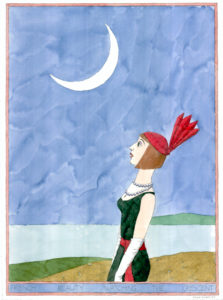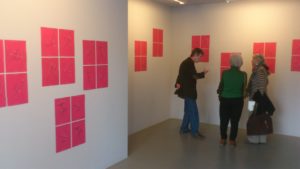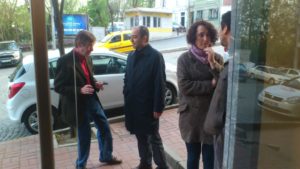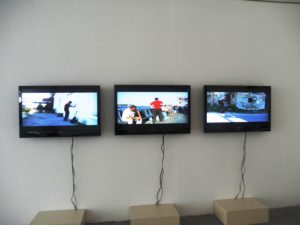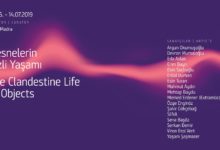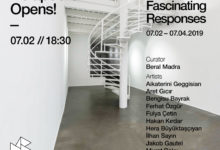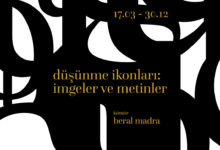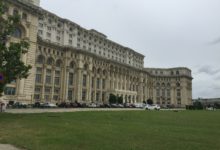NIKITA ALEXEEV
Avrasya Şarkıları/ Eurasian Songs
DUYU VE DUYARLILIK
Nikita Alexeev 1970-1980’lerde Moskova’nın yeraltı sanat ortamındaki birçok önemli etkinliğe katıldı. 1974’te Moskova’nın dış mahallelerinde yapılmasına izin verilen ilk açık alan öncü sanat etkinliğinde yapıtlarını sergiledi. Performansları ve metinleri ile “Moskova Romantik Kavramsalcılığı”nın (bu terim Boris Groys tarafından bulunmuştur) temelini oluşturan Moskova Kavramsal sanat okulunun öncüleri ve o dönemde önemli olan Kolektif Eylemler grubunun kurucuları arasındaydı.
Nikita Alexeev yalnız ilk Rus “Yeni Dalgacı”larından değil, 1982-1984 arasında Sovyetler Birliği’nin ilk resmi olmayan galerisi olan APTART’ın da sahibiydi: Tek odalı apartmanını genç radikal sanatçılara sundu ve yeni sanat akımının gelişmesini kolaylaştırdı. Perestroika döneminde sanatçı, etkin bir çalışmayla şiirden görsel sanatlara, rock müziğinden filme kadar bütün sanatları içeren özgür bir genç kültür imajının kurulmasını sağladı.
1987’de Alexeev, tanıdık bir iletişim ortamından yoksun olduğu Paris’e taşınarak (kendisine yabancı olan) toplumsal ve sanatsal ortamda bir çeşit manastır yalnızlığına büründü. Bugüne kadar sürdürdüğü kişisel üslubunun en gelişmiş halini alması ve özel bireysel konular ve biçimsel yöntemlerinin ortaya çıkışı “Paris Dönemi”nde gerçekleşmiştir.
Çelişkili görünse de, Nikita Alexeev, çağdaş sanatın kabul gören klasik durumundan haz alarak, sanatsal deneyimleri bir yana bıraktı ve 1993’te Rusya’ya döndükten kısa süre sonra gazeteciliğe başladı. Yine de, 2000’lerin başında, emektar bir kavramsalcıdan beklenmedik bir biçimde eşsiz şiirsel desenlerle Moskova sanat sahnesine dönüş yaptı.
Nikita Alexeev’in sanat geçmişinin bu kısa anlatımı yalnız onu İstanbul sanat izleyicisine tanıtmak için gerekli değil, onun güncel Rusya sanatındaki duruşunu açıklığa kavuşturmak ve (hem yaşamda hem de sanatta) stratejilerinin ana kaynağını özetlemek için de gereklidir.
Sanatçı, ana araç olarak grafiği – mürekkep ve suluboya, yağlı pastel ve renkli tebeşirle desenler – seçmiştir. Kağıt üstüne bu işleri uzun diziler oluşturur. Bu diziler geleneksel grafik sergilemesinden çok tamtamına yerleştirmeye benzeyen karmaşık mekânsal yapılara yayılır. Nikita Alexeev’in “grafik yerleştirmeleri”, çağdaş sanat için kullanılabilir olan teknoloji cephaneliğiyle oynayan bir performansın içine izleyiciyi katan sahne dekorasyonlu iç mekânlar değildir. Yerleştirmeler, Hollywood üslubu görsel etkilerin destansı büyüsü ya da katı bir biçimin öğesi yerine şiirsel metaforların yumuşak nefesiyle geçici ve duygusal titreşimli ortamlar sunar.
Varoluşsal ve mesleki açıdan, sanatçı tek bir yöntem kullanır: sessizce konuşur, fark edilmez olarak durur, ana sanat akımının merkezinde, sanatsal modanın odağında olma tehlikesiyle karşılaştığını fark ettiği anda ortalıktan kaybolur. Estetik yöntemlerin temeli olan bu belirgin gerçeklerden kaçma durumu, sanatçının anlamak ve izlemek isteyenlerin yarı şeffaf şiirsel metinlerin kırılgan buzu üstünden kaymalarını sağlamak arzusundan kaynaklanıyor.
Kuad Galeri için özel olarak ürettiği Avrasya Şarkıları’nda duygusal izlenimlerin ussal akıntılarla zorlandığı zihin serüvenleri vardır. Bu, aynı eski şiirdir, ama çeşitli engellerin sert kurallarıyla yapılanmıştır – medyayla, özneyle, yöntemlerle, sanatçının özgür iradesinin romantik yasalarıyla değil.
Karşılıklı direnişin, karşılıklı duyarlılığın ve duyunun denetimi ayrıntılı çözüm gerektiren anlamlı düğümleri keşfetmeye yardım eder. Bu düğümler, Rusya’nın Bizans İmparatorluğu’nun mirasçısı olduğu mitine dayanan çağdaş Rusya jeopolitiğini, ve büyük bir ülke için “özel bir yol” ve Rus halkının seçilmiş bir doğası olduğu kavramlarında temellenen modern Rusya’nın devlet ideolojisini kapsar. Nikita Alexeev bütün bu eski, ama direnen “Üçüncü Roma” ihtiraslarını, bütün bu ideolojik çorbayı, kendi kurallarına göre araştırır.
Haç ve hilal “Rus idea”sının temel simgeleri ve Rusya’da hâlâ sürmekte olan dinsel itirafların işaretleri olarak, desenden desene ilerler. Bunlar tüm projenin bölüm başlıklarında da vardır.
Bu “şarkı”nın burada ana konu olarak seçilmesi rastlantısal değildir (ve aynı zamanda sanatçının söylemi için bir mazeret de). Melodi ve dizeler, psikolojik olarak denetlenen gelgitli nefes, insan sesinin kişisel titreşimleri, sadelik ve özlü söz bir şarkının özellikleridir (müzikle birlikte var olabilen bir roman, öykü ya da başka bir anlatım biçimi değil), ki bu, zamanımızın ilke olarak çözümsüz olan acı olaylarını çözmek için onu evrensel bir yöntem yapar.
Aynı zamanda, sanatçının uzun zamandır ustalaştığı renk çözeltileri ve anlam kayması yöntemi Alexeev’in bu grafik dizisinin iki ana karakteridir. Her bir dizide renk, neredeyse folklorik türde bir korkusuzluğun temellendiği belirgin anlamlar ve yorumlar taşır. Hilal Şarkısını İzlemek’te renk utanmazcasına kitsch’tir, buna karşın İstanbul için Haç Şarkıları’nda renk apaçık azaltılmıştır; çünkü onu taşıyan desen değil, zemindir. Kampari Gündoğumu Şarkısı (İstanbul-Venedik ve Yine Geri Dönüş)’te renk yine işlevseldir, yaygaracı bir pembedir, o suçluluk bilmeyen “yapmacıklı” renktir, onun doğası boyanın reçetesindedir, sodayla karıştırılmış iğrenç bir içkidir.
Nikita Alexeev’in uzayıp giden, çekici şarkılarının “anlam kayması ideolojisi”, söz ve imgenin birbirine uyumsuzluğunda temellenir ki, burada gösterilen ve gösteren arasındaki boşluk sonu olmayan olası bir kavrayışa açılır. Anlamın kayması ilkesi, Nikita Alexeev’in kimi eleştirmenlerin sanrı yaratan devinim olarak yorumladığı bütün desenlerinde işlev görür. Karga ve lale, servi ve kibrit çöpü sessizce şarkı söyleyerek hilali dikkatle izler. İstanbul için Haç Şarkıları kentin üstüne yağar, ölçü ve nesnelerin işlevleri onların içinde harmanlanır – bir okyanus gemisiyle bir salatalığı başka ne birleştirebilir ki?
Nikita Alexeev’in şarkıları gülünç ve pervasızdır ve aynı anda haşin ve kurallara uygundur. Aynı zamanda, dolaşık anlamların çeşitli katmanları hesaplanamaz ve ancak biz sanatın “bir zanaat, bir din, bir siyaset, bir bilim” olmadığının bilincindeysek yorumlanabilirler. Ve Aleksandr Puşkin’in sözleri akla gelir: “Lordum, şiir, biraz saçma olmalıdır.”
Sasha Obukhova
İngilizceden çeviren: Beral Madra
******************************************************************************************
SENSE AND SENSIBILITY
In 1970-1980s Nikita Alexeev was involved in many significant events of Moscow artistic underground. He displayed his works at the first outdoor show of avant-garde art which was allowed by Soviet authorities to be held in the outskirts of Moscow, in 1974. He was among the pioneers of Moscow Conceptual art school and one of the founders of the Collective Actions group, an important art association for the moment, performances and texts of which articulated the basics of the “Moscow Romantic Conceptualism” (the term was coined by Boris Groys).
Nikita Alexeev is not just one of the first Russian “New Wavers”. From 1982 to 1984 he was an owner of APTART, the first unofficial gallery in the Soviet Union: he offered his one-room apartment for radical young artists and facilitated the development of new art movement. During the perestroika period, the artist actively constructed the image of free youth culture integrating all kinds of art, ranging from poetry and visual art to rock music and films.
In 1987 Alexeev moved to Paris where, deprived of the familiar communication environment, he acquired a sort of monastery solitude in the new (and alien to him) social and artistic milieu. It was the “Paris period” that saw the final development of his personal style and emergence of exclusive individual subjects and formal methods he is still using today.
Paradoxical, as it may seem, Nikita Alexeev enjoying the statute of a recognized classic of contemporary art, quit artistic experimentation and took up journalism soon after his return to Russia in 1993. Yet, in the early 2000s he made a comeback to the Moscow art scene with exquisite lyrical drawings, unexpected for a veteran conceptualist.
This short account of Nikita Alexeev’s artistic history is necessary not only to introduce him to the Istanbul public. It is also an opportunity to clarify his position in contemporary Russian art, on the one hand, and to outline the main sources of his strategies (both in life, and art), on the other.
The artist chose graphics – ink drawings and watercolors, works made by oil pastel and color crayon – as his main media. His works on paper formed extensive series. The series branched into complex spatial structures resembling full-fledged installations rather than traditional displays of graphics. Alexeev’s “graphic installations” are not scenically decorated interiors where narration unravels, involving a viewer in a sort of performance manipulating all the arsenal of technology available to contemporary art. They offer ephemeral, emotionally vibrant environments brought to life with an easy breath of poetical metaphors rather than the element of solid form or the epic magic of Hollywood style visual effects.
Existentially and professionally, the artist employs only one method: he speaks quietly, stays unnoticed, disappears at the moment when he is aware of a danger to find himself in the center of an art mainstream, in the focus of artistic fashion. This obvious escapism as the basis of aesthetical tactics is rooted in the desire of the artist to offer an opportunity to glide over the fragile ice of semi-transparent poetic texts for those who are interested in viewing and understanding them.
Adventures of mind where reason constrains streams of sentimental impressions are present in the Eurasian Songs project produced specially for the KUAD Gallery. It is the same old poetry, but it is structured according to the strict rules of various barriers – those of media, of subject, of methodology, not according to the romantic laws of the author’s free will.
Mutual resistance, mutual control of sensibility and sense helps to discover the meaningful nodes which require detailed decoding. These nodes include, in particular, contemporary Russian geopolitics based on the myth of Russia as a successor of the Byzantine Empire and modern Russian ideology of state based on the concept of chosen nature of the Russian people and of the “special way” for a great country. Nikita Alexeev explores all these old, but enduring “Third Rome” ambitions, all this ideological broth, according to his own rules.
The cross and the crescent as fundamental symbols of the “Russian idea” and signs of prevailing religious confessions in Russia travel from one drawing to another. They are also present in the titles of parts of the whole project.
It is not accidental that this “sing-song” was chosen as the main subject here (and an alibi of the author’s statement simultaneously). The melody, the lyrics, physiologically determined tidal breathing, personal vibrations of the human voice, simplicity and laconism are the traits of a song (and not of a novel or a story, or of any other narrative form capable of coexisting with music) which make it a universal method for the solving of “painful issues” of our time which are unsolvable on principle.
At the same time, color solutions and the method of the shift of meaning, mastered by the artist long ago, form the two main characteristics of Alexeev’s graphic series. In each of the series color carries profound intonations and interpretations as the foundation of fearlessness, nearly the one of a folklore type. While color is almost shamelessly kitsch in Watching the Crescent Song, color is clearly reduced in the Cruciform Songs for Istanbul for it is the base, not drawing that carries it. In the Campari Sunrise Song (Istanbul – Venice and Back Again) color is functional, it is a blatant hue of pink, of a “sugary” color that does not know guilt, its nature is in the recipe of the paint, a mawkish drink mixed with soda water.
The “shiftology” of lingering, captivating songs of Nikita Alexeev is rooted in the mismatch of a word and of an image where a gap between signified and the signifier opens up to an infinite flow of potential understanding. Principle of a shift of meaning is functioning in all his drawings, which some critics interpreted as a psychedelic move. A crow and a tulip, a cypress and a match sing voicelessly, contemplating a crescent. The Cruciform Songs for Istanbul scatter over the city. Scale and function of objects seem to be blended in them – for what could unite an ocean liner and a cucumber?
Nikita Alexeev’s songs are funny and reckless, and simultaneously severe and canonical. At the same time, all the levels of the entangled meanings are uncountable and can be interpreted only when we are aware that art is “neither a craft nor a religion, neither a politics nor a science”. And the words of Alexander Pushkin come to mind: “Poetry, my Lord, should be a bit foolish.”
Sasha Obukhova
Sasha Obukhova

